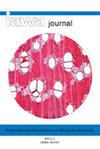被子植物干木质部组织管间凹坑膜上的人工脂质涂层
IF 1.4
3区 农林科学
Q2 FORESTRY
引用次数: 1
摘要
血管间池膜被认为是影响水流/栓塞阻力的关键结构。这些机制在很大程度上仍然不清楚,因为在本质上很难对其进行完整的审查。本研究调查了乙醇可提取的凹坑膜水垢(PMIs),这些水垢以前在某些被子植物中报道过,可能会影响它们的水传导。通过场发射扫描电子显微镜(FE-SEM)测定了40种被子植物PMIs的存在。通过木材提取物的化学分析确定了PMIs的候选成分,并通过飞行时间二次离子质谱法(TOF-SIMS)检测了它们在木质部中的分布。还进行了冷冻TOF SIMS和冷冻FE SEM,以阐明PMI的天然分布。在11个物种中观察到PMIs。其中一些被归类为脂肪树,已知脂肪树储存丰富的脂质。表现出PMIs的椴树边材含有大量的脂质,这些脂质分布在干燥的木质部组织中,与PMIs的分布一致。然而,在冷冻的T.japonica样品中,分布仅限于薄壁组织。总之,PMIs由源自室温下干燥样品中薄壁组织的人造脂质涂层组成。对植物细胞壁进行表面分析的研究人员应该采取强有力的预防措施,防止这些固有化学物质的自涂层。本文章由计算机程序翻译,如有差异,请以英文原文为准。
Artifactual lipid coatings on intervessel pit membranes in dried xylem tissues of some angiosperms
Intervessel pit membranes are recognized as key structures for influencing water flow/embolism resistance. The mechanisms remain largely unclear owing to difficulties in examining them intact in nature. This study investigates ethanol-extractable pit membrane incrustations (PMIs), which were previously reported in certain angiosperms and may affect their water conduction. The presence of PMIs was determined for 40 angiosperms by field-emission scanning electron microscopy (FE-SEM). Candidate components of PMIs were determined by chemical analyses of wood extracts, and their distributions in the xylem were examined by time-of-flight secondary ion mass spectrometry (TOF-SIMS). Cryo-TOF-SIMS and cryo-FE-SEM were also performed to clarify the native distribution of PMIs. PMIs were observed in 11 species. Some of them were categorized as fat trees, which are known to store abundant lipids. Tilia japonica sapwood displaying PMIs contained large amounts of lipids, which were distributed in the dried xylem tissue, consistent with the distribution of the PMIs. In the frozen samples of T. japonica, however, the distributions were restricted to the parenchyma. In conclusion, PMIs consist of an artifactual coating of lipids originated from the parenchyma in dried samples at room temperature. Researchers performing surface analyses of plant cell walls should take strong precautions against such self-coating by these intrinsic chemicals.
求助全文
通过发布文献求助,成功后即可免费获取论文全文。
去求助
来源期刊

IAWA Journal
农林科学-林学
CiteScore
3.40
自引率
15.80%
发文量
26
审稿时长
>36 weeks
期刊介绍:
The IAWA Journal is the only international periodical fully devoted to structure, function, identification and utilisation of wood and bark in trees, shrubs, lianas, palms, bamboo and herbs. Many papers are of a multidisciplinary nature, linking
 求助内容:
求助内容: 应助结果提醒方式:
应助结果提醒方式:


